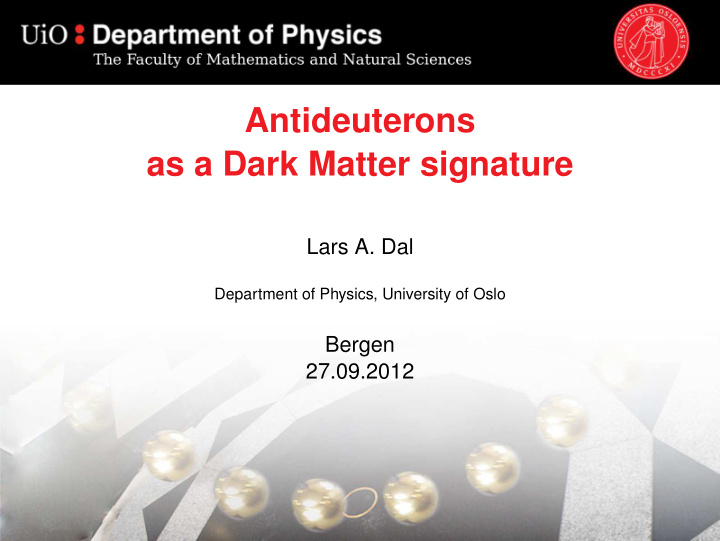



Antideuterons as a Dark Matter signature Lars A. Dal Department of Physics, University of Oslo Bergen 27.09.2012
Detection of Dark Matter Assume Dark Matter in the form of unknown particles Most DM candidates have couplings to standard model particles, allowing them to scatter or decay 3 ways to explore: Missing energy signatures in collider experiments Direct detection: Scattering on baryonic matter Indirect detection: Observation of DM decay/annihilation products as cosmic rays DM Detection Detection of Dark Matter 2 / 12
Indirect detection: Antideuterons Dark matter couples weakly to ordinary matter by definition ⇒ Low decay/annihilation rate ⇒ Small cosmic ray signature Need particle channels where the signal is not drowned by background. Antimatter Antideuterons: Lightest antinucleus: ¯ p ¯ n Very difficult to produce in cosmic ray collisions on interstellar matter So far only an upper limit exists on the cosmic ray antideuteron spectrum. Ongoing experiment: AMS-02 DM Detection Indirect detection: Antideuterons 3 / 12
Fancy picture of AMS-02 DM Detection Indirect detection: Antideuterons 4 / 12
Calculating the spectrum Same tree level processes are relevant for most DM types. Examples: XX → W + W − or XX → q ¯ q for annihilating DM X → W ± l ∓ for decaying fermionic DM X → W + W − for decaying scalar DM Spectrum for individual process depends only on M DM (in most models) Total spectrum in “any” model: Combine spectra using branching ratios of the specific model Spectrum for each process calculated using a Monte Carlo event generator Spectrum at Earth found using a Galactic propagation model Problem with antideuterons: Nucleus formation not handled by event generators, has to be implemented manually Calculating the spectrum Calculating the spectrum 5 / 12
The Coalescence Model Simple model for nucleus formation: Coalescence Nucleons with ∆ p < p 0 coalesce to form a nucleus p 0 calibrated against experimental data (LEP) Traditional approach: Assume isotropic and uncorrelated ¯ p and ¯ n spectra. Analytic solution: = p 3 � dN ¯ � � dN ¯ � � dN ¯ � m ¯ 1 p d d n 0 T i = E i − p i , � dT ¯ 6 m ¯ n m ¯ dT ¯ dT ¯ T 2 p d + 2 m ¯ n p d d T ¯ ¯ d Why not coalescence per-event? Requires factor ∼ 10 3 more events Isotropic assumption does not hold. Coalescence must be done per-event afterall. Requires huge number of events ( ∼ 10 8 ) Calculating the spectrum The Coalescence Model 6 / 12
Uncertainty from Hadronization Hadronization: The formation of hadrons from final state quarks and gluons Non-perturbative effects are important, only phenomenological models available Antideuteron production: Correlations between antinucleons are highly important. Very sensitive to the hadronization process Two dominant models: Cluster Model and Lund String model. Herwig++ and Pythia Compare ¯ d results from Herwig++ and Pythia to get an estimate on uncertainty from hadronization Article: L.A. Dal, M. Kachelriess. arXiv:1207.4560 [hep-ph] My work Uncertainty from Hadronization 7 / 12
Ratios of the spectra Consider 2 processes: XX → W + W − and XX → b ¯ b Ratio of spectra: Herwig++ / Pythia Large ratios at very high and very low energies. Interpretation: Large uncertainties My work Uncertainty from Hadronization 8 / 12
Uncertainty after Propagation Two-zone propagation model; max, med, min parameters Uncertainty from propagation dominant for most energies Hadronization: Uncertainty of factor 2-4 for most energies My work Uncertainty from Hadronization 9 / 12
Gravitino RPV Decays Gravitino: Supersymmetric partner of the graviton RPV: R-parity violation What is R-parity? Multiplicatively conserved quantum number R = ( − 1 ) 3 B + 2 s + L Introduced to remove couplings that allow the proton to decay SUSY particles can only be created or destroyed in pairs LSP absolutely stable, good DM candidate No a priori reason to be conserved RPV and Dark Matter: Neutralino unstable, poor DM candidate Gravitino unstable but long lived, good DM candidate Gravitino decays do not have the typical tree-level processes My work Gravitino RPV Decays 10 / 12
Antideuterons from ˜ G decays Goal: Set limits on RPV couplings λ RPV couplings set to 1 in calculations. d Φ dT ∝ λ 2 . dT ∼ 4 . 5 × 10 − 7 (m 2 s sr GeV/n) − 1 in the Estimated AMS-02 limit: d Φ ranges 0 . 2 − 0 . 8 GeV/n and 2 . 2 − 4 . 2 GeV/n ∗ Example: m ˜ G = 200 GeV, coupling: L 1 Q 3 ¯ D 3 Prospective AMS-02 limit: ∼ 10 − 7 λ < ∗ V. Choutko and F. Giovacchini, on behalf of the AMS Collaboration, Proceeding of the 30th International Cosmic Ray Conference (2007). My work Gravitino RPV Decays 11 / 12
Summary Antideuteron channel suitable for DM searches due to low background Spectrum calculated using Monte Carlo event generator + Coalescence model Hadronization leads to uncertainty of factor 2-4 for most energies, higher for very high or very low energies Current work: Gravitino RPV decays. Promising results for limits on RPV couplings Summary Summary 12 / 12
Recommend
More recommend